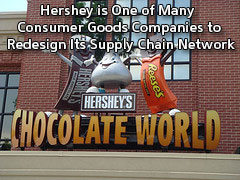Moving to SIOP
Sales and Operations Planning (S&OP) has become perhaps the defining process in achieving supply chain excellence, with its goal of aligning supply and demand into a consensus forecast that drives planning and execution across the entire enterprise. It takes time, but an increasing percentage of consumer goods companies have reached a high level of maturity in their S&OP processes, though many others are still early in that journey.
The leaders, however, are moving beyond traditional S&OP to more explicitly include targeted inventory levels for a given demand-supply plan. In general, standard S&OP left inventory decisions across the network to be determined later – not as part of the formal S&OP process.
The new approach, called Sales, Inventory and Operations Planning (SIOP), includes a step that forces company leaders to agree on an inventory plan and targeted customer service levels to meet the consensus forecast given variability, recognizing that there are risks in those decisions, and that the responsibility shouldn’t be largely passed off to inventory planners.
The analytic dashboards that are increasingly driving traditional S&OP meetings become even more important in SIOP – and supply chain technology vendors are providing an increasingly rich array of such tools.
Redesigning Supply Chain Networks
Almost every month, it seems, a major consumer goods company announces a plan for “supply chain transformation” that includes a major network redesign. Consumer goods companies that have announced such plans, which generally roll out over several years, include ConAgra, Hershey Foods, Kimberly Clark, Sony, and many more.
There are several themes running through many of these programs:
- Reduce fixed supply chain costs and total supply chain assets.
- Increase network flexibility.
- Increase use of outsourcing (see the two points above).
- Reduce supply chain operating costs, especially to combat rising transportation costs and help combat the impact of rising commodity costs on the bottom line.
- Use of Network Planning and Optimization software tools not only in the initial supply chain design, but on an on-going basis to continue to analyze and improve the network over time.
 Kimberly Clark Corp. (KCC), for example, is at the end of a four-year program for its “supply chain network of the future,” which involves closing dozens of plant-based distribution centers in favor of nine huge “mixing center” DCs that can ship the company’s full product line. KCC estimates that in 2007 it has already reduced transportation mileage by 13 million, and been able to shift an increasing amount of freight between plants and DCs to more low-cost intermodal movements versus truckload. Kimberly Clark Corp. (KCC), for example, is at the end of a four-year program for its “supply chain network of the future,” which involves closing dozens of plant-based distribution centers in favor of nine huge “mixing center” DCs that can ship the company’s full product line. KCC estimates that in 2007 it has already reduced transportation mileage by 13 million, and been able to shift an increasing amount of freight between plants and DCs to more low-cost intermodal movements versus truckload.
New Approaches to Collaboration
Formal Collaborative Planning, Forecasting, and Replenishment (CPFR) still has probably yet to meet its potential, but collaboration is actually increasingly popular in other forms.
Robert Nardone, a former supply chain executive at Unilever/Best Foods, for example, says that “It has become commonplace for consumer goods companies to include retail forecast information as part of demand planning and S&OP processes, even if it’s not formal CPFR.”
Web-based technologies, as well as the growth of “customer logistics teams” at consumer goods companies, are both important in improving that forecasting collaboration.
Supply chain collaboration shows up in many other ways as well. Campbell’s has a retail customer that was moving to new automated distribution systems.
The retailer contacted Campbell’s, requesting that it change a large number of its case-pack configurations to make them more suited for the new system. In the end, Campbell’s and the retailer sat down and reviewed the opportunities and costs SKU by SKU. Where it made sense (Campbell’s could do it with little or no cost impact), it made the change. Where it didn’t (negative impact on supply chain costs), they kept the current case-pack, and that was just fine with the retailer. The key – jointly looking at total supply chain costs.
Much of Hersheys’ volume comes in the Halloween season, and much of that is shipped in special displays that contain a lot less product for the cube than regular shipments. The result – very high transportation costs that cut into profits. Hershey’s took a look at this, and came up with some ideas that could meet merchandising needs but lower transport and handling costs. They approached a major retailer with the program, which required some ordering and logistics changes on the retailer’s end as well. The retailer accepted the program, resulting in a strong, positive impact to both sides.
Integrated Logistics
After years of talk by consumer goods companies and “supply chain execution” software vendors, the promise of “integrated logistics” systems and processes is finally starting to be realized.
Improved “visibility” is at the heart of these more integrated logistics chains, using information to better synchronize the movement of goods. So is the adoption of the “integrated logistics suites” of various supply chain software vendors. Largely more vision than reality just a few years ago, today many vendors have achieved solid integration among such components as Warehouse Management, Transportation Management, Labor Management, supplier portals, Yard Management, etc. John Sidell, a principal at TranSystems/ESYNC, told SCDigest for example, that “A majority of our clients are now looking to deploy WMS and TMS together, and that’s a big change from the past.”
But it’s more than just technology, of course – the reality of the competitive environment, the need to drive continuous cost reduction, the pressures of just-in-time inventories, etc., are making it essential to knock down functional boundaries across the supply chain.
|